Explanation:
The bracket before 0 indicates that 0 is in the set. The parenthesis after 6 indicates that only values up to, not including, 6 are included. This could also be written: 0 ≤ x < 6. Since no values below 0 are included, we can eliminate -1⁄2, 0, 1⁄2,1 as a possible answer because it includes - ½. We can also eliminate 1⁄2, 1, π, 6 because it includes 6. Since 2 π is 6.28, 1, π, 3, 2π is also eliminated.

Explanation:
We must distribute the 3x to the (x + y) term in this issue. By doing this, you get 3x2 + 3xY + X. Since the x-terms are different, this cannot be further simplified (one is squared and one has a y attached).
Explanation:
We require two numbers that have a product of 4 and a sum of 5, as a*c=2*2 = 4 and b=5. The correct numbers are 4 and 1. Thus, 2x2 + 5x + 2 equals 2x2 + 4x + x + 2 equals (x + 2). 2x + (x+2)1 = (x+2)(2x+1)
Explanation:
Given that -1 is less than or equal to 12, a dot should be placed there, and a solid line should extend to 12. Since 12 is not a part of the equation, there should be an empty circle there.
Explanation:
The lowest data point, the first quartile, the interquartile range, the third quartile, and the highest data point are the components of a boxplot. Q1 relates to the interquartile range's leftmost edge (the rectangular region). Q1 in this instance is 3. Q3 is equal to 10, or the rightmost edge.